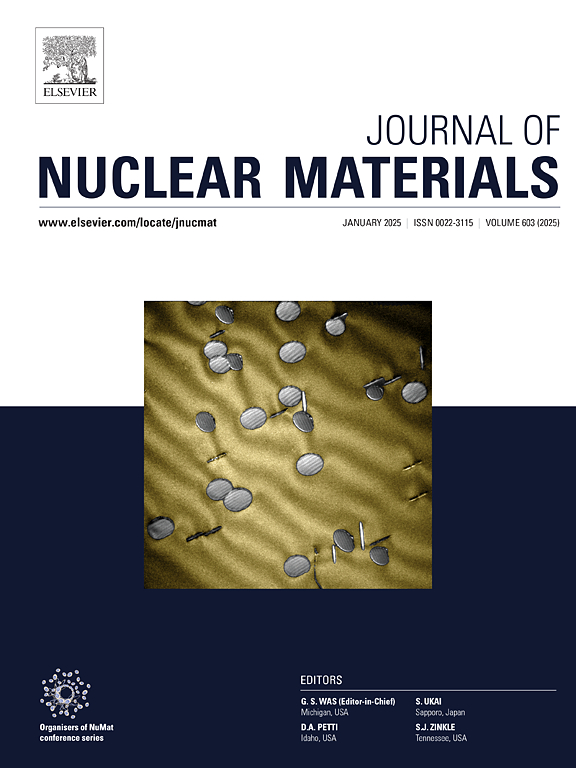Increasing Tc retention during nuclear waste vitrification: Effect of alumina source on the rate of rhenium incorporation into glass
IF 2.8
2区 工程技术
Q3 MATERIALS SCIENCE, MULTIDISCIPLINARY
引用次数: 0
Abstract
Technetium (Tc) volatilization during nuclear waste vitrification poses a significant challenge, necessitating recycle loops that may lead to reduced waste loading in the glass, or secondary Tc treatment in alternative waste forms. Thus, reducing the volatilization of Tc (or Re, its non-radioactive surrogate) is crucial for improving vitrification process efficiency and minimizing the long-term costs associated with nuclear waste management. In our previous study, we demonstrated that using gibbsite, instead of kyanite, as the alumina source in low-activity nuclear waste melter feeds increased the Re retention by up to 20 %, a result attributed to the formation of nanocrystalline alumina in the gibbsite-containing melter feeds. In this work, we show that using boehmite, another Al-source that forms nanocrystalline alumina polymorphs upon heating, results in an even higher retention of Re, by up to 25 %. Using X-ray diffraction and deionized water leaching tests on heat-treated feed samples, we analyzed the compositions of soluble oxyanionic salt phase and the insoluble glass-forming phase as a function of temperature, and evaluated the rate of Re incorporation into the developing transient alkali-alumino-borosilicate melt. We found that the formation of nanocrystalline alumina in the boehmite-containing feed occurred at temperatures approximately 100 °C lower than in the gibbsite feed, accelerating reactions between alumina, oxyanionic salts, and the borosilicate melt, which likely accounts for the enhanced Re retention in the boehmite-containing feeds.
在核废料玻璃化过程中增加Tc保留率:氧化铝源对铼进入玻璃的速率的影响
在核废料玻璃化过程中,锝(Tc)的挥发构成了一个重大挑战,需要回收循环,这可能导致减少玻璃中的废物负荷,或者在替代废物形式中进行二次Tc处理。因此,减少Tc(或其非放射性替代物Re)的挥发对于提高玻璃化过程效率和最大限度地减少与核废料管理相关的长期成本至关重要。在我们之前的研究中,我们证明了在低活性的核废料熔体原料中使用三水铝石而不是蓝晶石作为氧化铝源,可以使Re保留率提高20%,这是由于在含有三水铝石的熔体原料中形成了纳米晶氧化铝。在这项工作中,我们表明,使用薄水铝石,另一种铝源,在加热时形成纳米晶氧化铝多晶,导致更高的Re保留率,高达25%。通过x射线衍射和去离子水浸出试验,分析了可溶性氧化阴离子盐相和不溶性玻璃形成相的组成与温度的关系,并评价了正在形成的瞬态碱铝硼硅酸盐熔体中稀土的掺入率。我们发现,纳米晶氧化铝在含薄铝石进料中形成的温度比在三水铝石进料中低约100℃,加速了氧化铝、氧化阴离子盐和硼硅酸盐熔体之间的反应,这可能是含薄铝石进料中Re潴留增强的原因。
本文章由计算机程序翻译,如有差异,请以英文原文为准。
求助全文
约1分钟内获得全文
求助全文
来源期刊

Journal of Nuclear Materials
工程技术-材料科学:综合
CiteScore
5.70
自引率
25.80%
发文量
601
审稿时长
63 days
期刊介绍:
The Journal of Nuclear Materials publishes high quality papers in materials research for nuclear applications, primarily fission reactors, fusion reactors, and similar environments including radiation areas of charged particle accelerators. Both original research and critical review papers covering experimental, theoretical, and computational aspects of either fundamental or applied nature are welcome.
The breadth of the field is such that a wide range of processes and properties in the field of materials science and engineering is of interest to the readership, spanning atom-scale processes, microstructures, thermodynamics, mechanical properties, physical properties, and corrosion, for example.
Topics covered by JNM
Fission reactor materials, including fuels, cladding, core structures, pressure vessels, coolant interactions with materials, moderator and control components, fission product behavior.
Materials aspects of the entire fuel cycle.
Materials aspects of the actinides and their compounds.
Performance of nuclear waste materials; materials aspects of the immobilization of wastes.
Fusion reactor materials, including first walls, blankets, insulators and magnets.
Neutron and charged particle radiation effects in materials, including defects, transmutations, microstructures, phase changes and macroscopic properties.
Interaction of plasmas, ion beams, electron beams and electromagnetic radiation with materials relevant to nuclear systems.
 求助内容:
求助内容: 应助结果提醒方式:
应助结果提醒方式:


